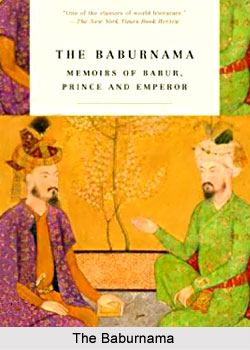 Memoirs of Babur have started from his accession to the throne of his father. Babur wrote his autobiography titled Tuzk-i-Baburi (titled Baburnama in Persian) in his mother tongue. There are certain gaps in the manuscript Babur could not add to his biography between the year 1508-1519, 1520, 1525 and 1529-1530. The autobiography is the best source to know the events of the life of Babur. The description of Babur is clear, impressive and quite near the truth. Of course, he misunderstood many things particularly in case of India and therefore has given wrong version but the attempt was not deliberate. A fairly good idea about his knowledge, his virtues and vices, his pleasures and sufferings, political circumstances which he faced, the climate, flora and fauna of the countries which he visited, his tastes and desires and the description of those people with whom he came in contact during his rule is obtained from his writings. Besides, the description of Babur friends and foes, his emotional reaction to individuals and circumstances, natural beauty of mountains, rivers, forests and towers are very much absorbing which credits his biography as a beautiful piece of literature.
Memoirs of Babur have started from his accession to the throne of his father. Babur wrote his autobiography titled Tuzk-i-Baburi (titled Baburnama in Persian) in his mother tongue. There are certain gaps in the manuscript Babur could not add to his biography between the year 1508-1519, 1520, 1525 and 1529-1530. The autobiography is the best source to know the events of the life of Babur. The description of Babur is clear, impressive and quite near the truth. Of course, he misunderstood many things particularly in case of India and therefore has given wrong version but the attempt was not deliberate. A fairly good idea about his knowledge, his virtues and vices, his pleasures and sufferings, political circumstances which he faced, the climate, flora and fauna of the countries which he visited, his tastes and desires and the description of those people with whom he came in contact during his rule is obtained from his writings. Besides, the description of Babur friends and foes, his emotional reaction to individuals and circumstances, natural beauty of mountains, rivers, forests and towers are very much absorbing which credits his biography as a beautiful piece of literature.
Babur gave a description of India as well in his biography. He wrote of the climate, the people, and their economic and social editions and about the kings and political events in India. About India he wrote that Hindustan was a country of few charms, where people have no good looks or manners. Describing the political condition of India he wrote that the capital of India is Delhi and also described something about the kingdoms of Malwa, Gujarat, Bahamani kingdom, Mewar and Vijayanagara.
The description of Hindustan by Babur is neither complete nor entirely correct. He made no mention of the states of Orissa, Khandesh, Sindh and Kashmir in his Memoirs. Besides, as he got very little time to access the Indian conditions and remained busy mostly in conducting wars, his description cannot be regarded accurate as well. If Babur would have got more time and would have got the opportunity to come in contact with the cultured people of India, probably, he would have revised his opinion about the Indian people. Besides, Babur viewed Indian people from the eyes of a conqueror. If he would have remained alive till the political condition of India would have stabilised, his opinion would have been certainly different.



















